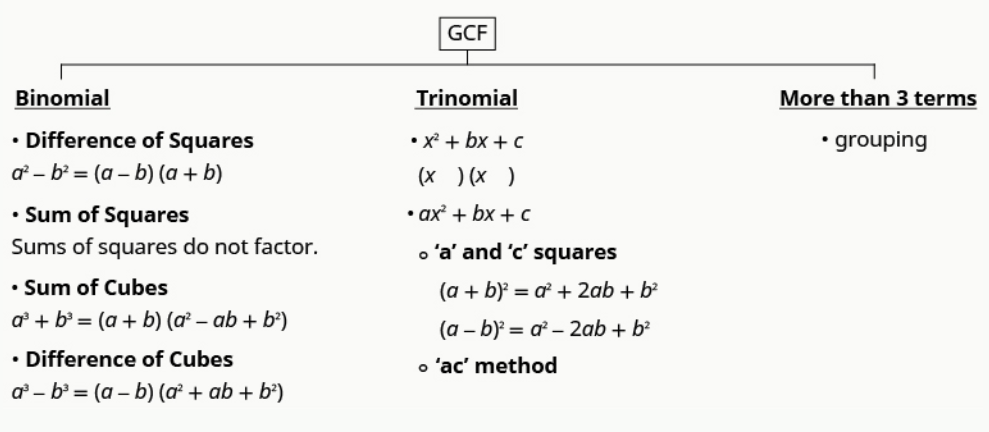Complete Factorization : a polynomial is factored completely if it can't be broken down any further.
This topic brings together the ideas of this chapter.
Example: $5x^5-5x y^4$
$$
\begin{array}{lll}
\displaystyle5x^5-5x y^4 &\displaystyle=5x(x^4-y^4) &\mbox{factor out GCF}\\
\displaystyle &\displaystyle= 5x\left((x^2)^2-(y^2)^2\right)&\mbox{prep for difference of squares}\\
\displaystyle &\displaystyle=5x(x^2+y^2)(x^2-y^2) &\mbox{factor difference of squares}\\
\displaystyle &\displaystyle= 5x(x^2+y^2)(x+y)(x-y)&\mbox{factor difference of squares again!}\\
\end{array}
$$
This cannot be broken down any further, so it is a complete factorization.
Factoring Strategy

Factoring Strategy: Step by Step
Step 1: Is there a greatest common factor?
- If yes, factor it out.
- If it's a binomial,
- is it a sum of squares? Sums of squares do not factor.
- is it a sum of cubes? Use the sum of cubes pattern.
- is it a difference of squares? Factor using the difference of squares pattern (a product of conjugates).
- is it a difference of cubes? Use the difference of cubes pattern.
-
If it's a trinomial,
- is it of the form $x^2 + bx + c ?$ Find two numbers which add to $b$ and multiply to $c$ and factor.
- is it of the form $ax^2 + bx + c ?$ If $a$ and $c$ are squares, check if it fits the trinomial square pattern. Otherwise, use the trial and error or “$ac$” method if necessary.
- If it has more than three terms, use the grouping method.
- Is it factored completely?
- Do the factors multiply back to the original polynomial?
Examples: Factor the following polynomial expressions.
$y^3 +7 y^2 -y - 7$
$$
\begin{array}{lll}
\displaystyle y^3 +7 y^2 -y - 7&\displaystyle=y^2(y +7) -(y + 7) &\mbox{factor by grouping}\\
\displaystyle &\displaystyle=(y^2-1)(y+7) &\mbox{pull out common factor}\\
\displaystyle &\displaystyle=(y+1)(y-1)(y+7) &\mbox{factor difference of squares}\\
\end{array}
$$
$245 s^3 a-20 s a^3$
$$
\begin{array}{lll}
\displaystyle 245 s^3 a-20 s a^3&\displaystyle= 5sa(49s^2-4 a^2) &\mbox{factor out GCF}\\
\displaystyle &\displaystyle=5sa(7s+2 a)(7s-2 a) &\mbox{factor difference of squares}\\
\end{array}
$$
$2 z p^2-2 z c^4$
$$
\begin{array}{lll}
\displaystyle 2 z p^2-2 z c^4&\displaystyle=2z(p^2-c^4) &\mbox{factor out GCF}\\
\displaystyle &\displaystyle=2z(p+c^2)(p-c^2) &\mbox{factor difference of squares}\\
\end{array}
$$
$36t^2-25c^2-40c-16$
$$
\begin{array}{lll}
\displaystyle 36t^2-25c^2-40c-16 &\displaystyle=36t^2-(25c^2+40c+16) &\mbox{regroup}\\
\displaystyle &\displaystyle=36t^2-((5c)^2+2(5c)(4)+4^2) &\mbox{factor a perfect square trinomial}\\
\displaystyle &\displaystyle=36t^2-(5c+4)^2 &\mbox{rewrite as square}\\
\displaystyle &\displaystyle=(\color{magenta}{6t})^2-(\color{blue}{5c+4})^2 &\mbox{recognize a difference of squares}\\
\displaystyle &\displaystyle=(\color{magenta}{6t}+(\color{blue}{5c+4}))(\color{magenta}{6t}-(\color{blue}{5c+4})) &\mbox{factor difference of squares}\\
\displaystyle &\displaystyle=(6t+5c+4)(6t-5c-4) &\mbox{rewrite as square to reveal a difference of squares}\\
\end{array}
$$
$3mv^4 + 192mv$
$$
\begin{array}{lll}
\displaystyle 3mv^4 + 192mv&\displaystyle=3mv(v^3+64) &\mbox{factor out GCF}\\
\displaystyle &\displaystyle=3mv(v^3+(4)^3) &\mbox{spot sum of cubes}\\
\displaystyle &\displaystyle=3mv(v+4)\left((v)^2-(v)(4)+(4)^2\right) &\mbox{factor sum of cubes}\\
\displaystyle &\displaystyle=3mv(v+4)\left(v^2-4v+16\right) &\mbox{simplify}\\
\end{array}
$$
$u^2+2u+1+u t+t$
$$
\begin{array}{lll}
\displaystyle u^2+2u+1+u t+t&\displaystyle=(u+1)^2+t(u+1) &\mbox{factor perfect square trinomial and by grouping}\\
\displaystyle &\displaystyle=(u+1)(u+1)+t(u+1) &\mbox{optional prep step}\\
\displaystyle &\displaystyle=((u+1)+t)(u+1) &\mbox{factor out common factor}\\
\displaystyle &\displaystyle=(u+1+t)(u+1) &\mbox{lose parentheses}\\
\end{array}
$$
$75m^3 + 12m$
$$
\begin{array}{lll}
\displaystyle 75m^3 + 12m&\displaystyle=3m(25m^2+4) &\mbox{factor out GCF}\\
\end{array}
$$
Why did we stop?